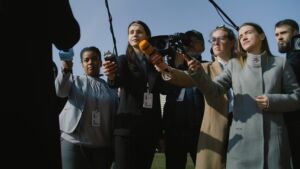As the Port of Baltimore slowly reopens to commercial traffic and the delicate process of removing the massive steel pieces from what is left of the Francis Scott Key Bridge, it’s not too early to find crisis communications lessons from how information about the disaster was disseminated.
The importance of staying in the message box during a crisis was ably demonstrated within hours after the accident by National Transportation Safety Board (NTSB) chairperson Jennifer Hominy. She was soon on the scene in Baltimore and ran a textbook press conference, focusing on the facts known at the time and the investigation parameters. Unlike a typical media interview which should include examples and storytelling, the message box is used during a crisis interview to stick closely to a tight set of messages. When there is little information to divulge, the message box strategy provides a set of facts that are known, conveys transparency, and avoids responding to hypothetical questions or having to say, “no comment.” As the lead investigating agency, the NTSB will typically “plant the flag” with an initial media briefing to establish their authority.
The NTSB has a reputation as a trusted agency for accident investigations. It also has a well-developed strategy for communications. It drills and practices for what and how it can communicate. Other organizations should study its approach and how they can adapt it to their crisis communications playbooks.
It’s important to check the templates in your crisis communications plan before a disaster strikes to ensure your organization’s playbook is relevant. Here are recommendations:
- Update your list of potential crises – Older plans may not adequately address newer elements such as deep fakes or cyber issues.
- Address your communications channels – If your organization is hit with a cyber-attack, the typical outbound social media channels may be temporarily disabled. Establish a work-around to communicate to employees and external stakeholders.
- Have a robust monitoring tool in place – This is important for proactive public relations and essential during a crisis. When the Key Bridge collapsed, conspiracy theorists immediately began to disseminate false information. Communicators need to track the posts and diffuse misinformation as quickly as possible.
CommCore Can Help Before, During, and After a Crisis
From cyberattacks to automotive safety, from ethical lapses in the C-suite to social media gaffes, no organization is immune from modern crises, and their crippling effects on operations and reputations.
We believe crisis communications planning is an investment; not an expense.
- Studies indicate that every dollar spent on crisis communications planning is worth $7 in losses averted.
- A report by Hotwire suggests that 45% of senior communications executives do not have a crisis communications plan.
- 80% said they were worried that a crisis event would someday affect their organization.
As a leading crisis communications firm, for almost 40 years CommCore has helped organizations be ready — prepared prior to a crisis — and working side-by-side both during and after a crisis to communicate the right message at the right time.
We partner with our clients to ensure they are properly prepared before, supported during and help them protect brands and reputations after a crisis.
Contact our Crisis Communications Trainers & Consultants
We are available and can put you in touch with the right person to help with your specific crisis communications challenge.
To schedule a PressureTest™ Demo or get answers quickly, call us at (202) 659-4177 or email info@CommCoreConsulting.com to contact our crisis communications firm today.



